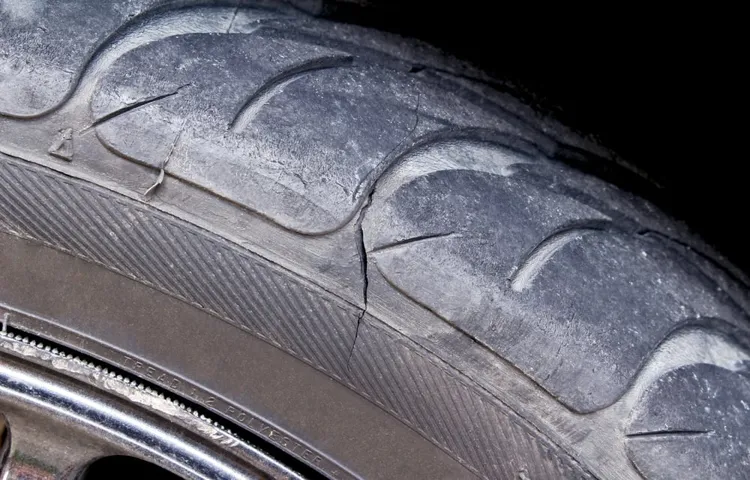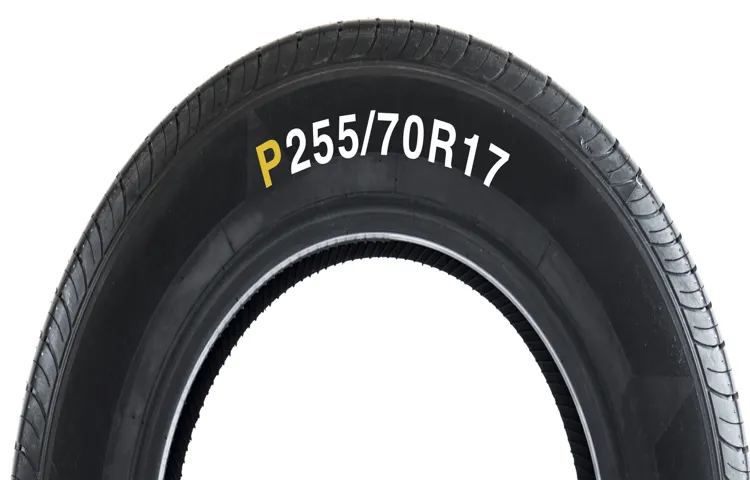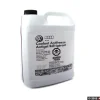Are you someone who has seen the term sidewall thrown around by tire experts but still unsure what it means? Don’t worry; you’re not alone! The sidewall of a tire is an essential part that is often overlooked unless there’s a problem. A tire’s sidewall is the part of the tire that connects the tread to the wheel. It’s the area on the sides of your tire that is visible when looking at it from the side.
The sidewall contains valuable information, including tire size, speed rating, and load index, to help drivers choose the right tire for their vehicle. In this blog post, we’ll dive deeper into what exactly is a sidewall and why it’s a crucial aspect of your tires. So buckle up and get ready to learn more!
Table of Contents
Understanding Tire Anatomy
When looking at a tire, you’ll notice the sidewall, which is the vertical part of the tire between the tread and the wheel. This section plays a critical role in supporting the weight of the vehicle while protecting the internal components of the tire. It also contains a lot of important information about the tire, such as the manufacturer’s name, the size of the tire, and the load capacity.
Each tire has a unique sidewall design, allowing consumers to make informed decisions when purchasing new tires. Knowing what is a sidewall on a tire will give you the knowledge to understand the essential feature and help you identify the right tire for your vehicle. So, the next time you’re purchasing new tires, be sure to pay attention to the sidewall for it contains valuable information that can make all the difference in your driving experience!
Tread vs Sidewall
When it comes to choosing the right tire for your vehicle, understanding the anatomy of a tire can be helpful. A tire is made up of two main parts: the tread and the sidewall. The tread is the portion of the tire that comes into contact with the road and provides traction.
It is designed to channel water, snow, and mud away from the tire to maintain grip on the road. The sidewall is the vertical surface that connects the tread to the wheel. It is responsible for holding the tire’s shape and helps to absorb shock when driving over bumps and obstacles on the road.
Both the tread and the sidewall are important for the overall performance and safety of your vehicle. When choosing a tire, it’s important to consider the specific needs of your vehicle and the driving conditions you will encounter. So, whether you are looking for a tire with excellent traction or one that can handle rough terrain, understanding the various components of a tire can help you make an informed decision.

Components of a Sidewall
Understanding tire anatomy is essential to appreciate how the different parts of a tire work together to provide a smooth and safe ride. One of the essential components of a tire is the sidewall. The sidewall is the part of the tire that sits between the tread and the wheel rim and supports the weight of the vehicle.
It is identifiable as the outermost layer that features the tire’s brand and model, tire size, and other information. The sidewall plays a crucial role in keeping the tire in shape by protecting the tire’s inner layers from damage caused by road hazards and other elements. The sidewall’s construction varies from tire to tire and usually includes one or more layers of plies made of steel, polyester, or nylon.
The plies work together to give the tire its strength and rigidity. Therefore, understanding the different components of a sidewall is necessary to choose the right tire for your vehicle, guaranteeing a safe and comfortable ride on different surfaces.
Importance of Sidewalls
If you are wondering what a sidewall is on a tire, it is the part of the tire that connects the tread to the wheel. The sidewall of a tire is crucial because it provides the structural integrity of the tire, allowing it to support the weight of the vehicle. The sidewall also protects the tire from damage by absorbing shock and compression.
In addition, the sidewall of the tire provides information about the tire’s specifications, including its size, type, and load capacity, allowing drivers to ensure that they are using the correct tire for their vehicle. When it comes to replacing your tires, it is important to ensure that the sidewall is in good condition to ensure the safety of your vehicle on the road. A damaged sidewall can lead to tire failure, potentially causing accidents and putting your safety at risk.
Therefore, it is important to keep an eye on your tire’s sidewall, ensuring that it remains free of cracks, cuts, and other signs of wear and tear. Remember, your sidewall plays a crucial role in the safety and performance of your vehicle and should not be overlooked.
Stability and Handling
When it comes to stability and handling of your vehicle, the importance of sidewalls cannot be overstated. These are the thick rubber layers that sit between the rim and the tread of your tires, and they play a vital role in ensuring that your vehicle stays upright and doesn’t swerve out of control. Sidewalls also help to absorb shocks and impacts from bumps and potholes on the road, providing a smooth and comfortable ride for both you and your passengers.
In addition, they help to maintain the shape and structural integrity of your tire, preventing it from slipping or sliding on wet or icy roads. Overall, a strong and sturdy sidewall is key to achieving optimal stability and handling in any driving situation, from high-speed highway cruising to navigating winding mountain roads. So if you want to ensure the safety and performance of your vehicle, make sure to invest in quality tires with reliable and durable sidewalls.
Load Capacity
Load Capacity, Sidewalls When it comes to choosing the right tires for your vehicle, load capacity is a vital factor to consider. Load capacity refers to the weight that a tire can safely carry, and it’s crucial to ensure that your tires can support the weight of your vehicle and its cargo. But did you know that sidewalls play an essential role in determining a tire’s load capacity? Sidewalls are the unsung heroes of tires, providing support and stability for the tire’s structure.
The strength and durability of a tire’s sidewalls directly impact its load capacity, making them a critical component to assess when selecting tires for your vehicle. So, when shopping for tires, be sure to evaluate the sidewalls’ strength and durability, as they could make all the difference in ensuring a safe and comfortable driving experience on the road.
Aesthetic Appeal
When it comes to the aesthetic appeal of a building or any structure, we often overlook the importance of sidewalls. Sure, they may seem like just another vertical surface, but they play a crucial role in the overall look and feel of the building. Sidewalls can either enhance or detract from the beauty of a structure and can even affect the value of the property.
The type of material used for the sidewalls, the color, the texture, and the design all need to be carefully considered to create a cohesive and visually appealing look. After all, the sidewalls are often the first thing that people see when they approach a building. So, it’s essential to give them the attention they deserve.
By choosing the right materials and design for your sidewalls, you can bring out the best in your building and make it stand out from the rest.
Sidewall Features to Consider
When it comes to tires, the sidewall is an essential component that plays a crucial role in ensuring road safety. The sidewall is the part of the tire that connects the tread to the wheel and provides necessary support to the vehicle’s weight. The sidewall also contains critical information about the tire itself, including its size, speed rating, and load capacity.
When selecting a tire, it’s important to consider the sidewall features carefully. One crucial aspect is the sidewall design, which can have a significant impact on the tire’s performance. Some sidewalls feature thicker rubber for additional protection against curbs and other obstacles, while others may have decorative elements or designs for a more personalized look.
It’s also essential to consider the type of sidewall construction. Radial tires have a stiffer sidewall, providing better handling and stability, while bias-ply tires tend to have a more flexible sidewall, providing a smoother ride. Understanding the various sidewall features can help you select the appropriate tire for your vehicle and ensure optimal performance while on the road.
Size and Profile
When choosing the right tires for your vehicle, size and profile are of utmost importance. Sidewall features play a crucial role in determining the overall performance of the tire. Features such as the aspect ratio, which is the height of the sidewall as a percentage of the width, can significantly impact your vehicle’s handling and ride quality.
Additionally, the width of the tire will affect the amount of grip you have on the road, which can improve your car’s overall stability. The tread pattern on the sidewall can also impact the overall performance of the tire, affecting everything from wet weather handling to fuel efficiency. When selecting the appropriate size and profile, it’s essential to consider these features to ensure the best possible grip, handling, and overall performance.
So, whether you’re driving a small sedan or a large SUV, be sure to choose the appropriate size and profile to ensure maximum safety and performance on the road.
Construction Materials
When it comes to building or renovating a property, choosing the right materials is crucial. One important aspect to consider is the type of sidewall features you want to install. The most common sidewall construction materials are brick, stucco, and wood, each with their own benefits and drawbacks.
Brick is a popular choice due to its strength and durability, but it can be costly and may take longer to install. Stucco is a cost-effective option that provides insulation and energy efficiency, but it can crack or become damaged over time. Wood is a versatile material that gives properties a traditional and rustic look, but it requires more maintenance and is prone to rotting or insect infestations.
Ultimately, the decision depends on your personal preferences, budget, and the climate in which your property is located.
Maintaining Tire Sidewalls
If you own a car, you know that the tire sidewall plays an important role in keeping your vehicle safe on the road. The sidewall is the area of the tire that connects the tire tread to the wheel and is crucial in maintaining the structural integrity of your tire. However, sidewall damage can occur due to various reasons such as under-inflation, over-inflation, hitting a curb, or driving over potholes.
To maintain your tire sidewalls, you should inspect them regularly for cuts, punctures, and cracks, and ensure that your tires are inflated to the recommended pressure. Driving on damaged sidewalls can lead to a blowout and could result in a serious accident. So, make sure to keep an eye on your tire sidewalls, and if you notice any damage, get them replaced as soon as possible.
Remember, your tire sidewalls are an important safety component of your vehicle, and regular inspections and maintenance can keep you and your passengers safe on the road.
Conclusion
In summary, a sidewall on a tire is like the unsung hero of the tire world – often overlooked but absolutely essential. It provides crucial information about the tire’s size, type, speed rating, and more, while also helping to absorb impacts and provide stability. So, just like a good friend who may not always steal the spotlight but is always there when you need them, we should give some love and appreciation to our tire sidewalls.
After all, they are the real MVPs of the road!”
FAQs
What is a sidewall on a tire?
The sidewall of a tire is the part of the tire that extends from the bead to the tread.
What is the purpose of the sidewall on a tire?
The sidewall on a tire provides protection and support for the tire, as well as containing important information about the tire, such as size and maximum load.
What are some common features of tire sidewalls?
Tire sidewalls often feature raised lettering or graphics, which can be used for branding or personalization purposes. They may also have ridges or grooves for aesthetic or functional reasons.
Can the sidewall of a tire be repaired?
It is generally not recommended to repair a damaged sidewall on a tire, as this can compromise the structural integrity of the tire and lead to potential safety hazards.
What should I look for in a high-quality tire sidewall?
A high-quality tire sidewall should be durable, resistant to punctures and abrasions, and able to withstand varying weather conditions. It should also be easy to read and provide accurate information about the tire’s specifications.
Can the color of a tire sidewall affect its performance?
No, the color of a tire sidewall does not affect its performance. It is purely a cosmetic feature.
How should I maintain the sidewalls of my tires?
To maintain the sidewalls of your tires, it is important to keep them clean and free of debris. You should also avoid driving over curbs or other obstacles that could cause damage to the sidewall.



